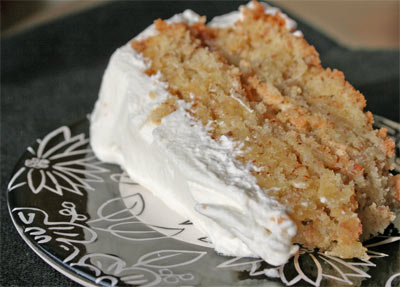
GLUTEN FREE FLOUR 101
Gluten Free Mommy Blog Readers’ Frequently Asked Questions
Is there a 1:1 flour substitution for wheat flour?
No. Gluten free flours work best in baking (most of the time) when they are used in combination with each other. However, there are some exceptions- recipes that call for a small amount of flour (like Orange Almond brownies) may work well with a 1:1 brown rice flour substitution. Another example where you wouldn’t need a gluten-free flour mix combination would be when thickening a sauce like my Green Bean Casserole recipe- sweet rice flour would be a fine 1:1 substitution in that instance.
When going gluten-free, how did you pick which flours to buy first?
Unfortunately, there is not a one-size fits all solution! You need to decide what is important to you when you start experimenting with flour mixes.
Typical considerations:
- glycemic index- this would be a good thing for everyone to consider but especially diabetic celiacs or those trying to lose weight.
- additional allergies- if you have to adhere to a casein-free or nut-free diet, you would obviously need to take this in consideration when picking a mix.
- taste- not everyone likes the same things! For example, whole grain teff flour tastes great to me in a lot of cakes, but some of my readers prefer not to use teff because they personally don’t like the taste it imparts on some baked goods.
- whole grain- getting enough whole grains is on everyone’s mind these days. I try to utilize whole grain flours in my gluten-free baking mix to make sure my family is getting the daily whole grains they need.
- performance- this simply means how well your mix performs. Is the cake moist? How is the texture? Does it taste good? Some people make sure to use all whole grains in their flour mix- I will occasionally compromise this (for example: in the case of tapioca flour) if I feel the overall recipe will be better for it. In my opinion, a cupcake is not supposed to be completely good for you.
- digestion- some people do not tolerate certain flours well. I don’t use bean flours at all. Enough said there!
- cost- some flours are more expensive than others
- availability- with online stores this is becoming less of an issue, but I like to have some local sources to buy gluten-free flour as well
Should you just buy a store-bought pre-made mix or make your own?
Pre-made mixes work well for a lot of people. Pamela’s Baking Mix can be a great all-purpose gluten-free flour, but there are drawbacks. It can be expensive and I find that my own homemade mixes perform better than Pamela’s- for example, my pumpkin pancake experiment. Another popular mix is Bob’s Red Mill All-Purpose Gluten Free Mix, but the bean flour keeps me far away from that gluten-free flour mix.
Where do you store your flours?
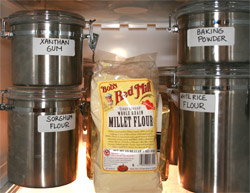 I keep my gluten-free flours in the refrigerator in canisters for a longer shelf life (whole grain flours do get rancid because they haven’t been over-processed and stripped of their nutrition like regular all-purpose flour) and because it is more convenient for me. Some people do fine with their pantry because they use the flours so quickly and they may have limited refrigerator space. I use labeled canisters because my fridge looks neater and it is easier to prevent messy flour spills. I know some people who handle it beautifully, but I could never get the hang of it and I ended up with a wad of 12 different zip lock bags in the fridge. If you pre-make your flour-mix all you need is one zip lock bag or one canister, but since I am always experimenting or using different flours I have one canister of pre-made mix and keep the flours in separate canisters also.
I keep my gluten-free flours in the refrigerator in canisters for a longer shelf life (whole grain flours do get rancid because they haven’t been over-processed and stripped of their nutrition like regular all-purpose flour) and because it is more convenient for me. Some people do fine with their pantry because they use the flours so quickly and they may have limited refrigerator space. I use labeled canisters because my fridge looks neater and it is easier to prevent messy flour spills. I know some people who handle it beautifully, but I could never get the hang of it and I ended up with a wad of 12 different zip lock bags in the fridge. If you pre-make your flour-mix all you need is one zip lock bag or one canister, but since I am always experimenting or using different flours I have one canister of pre-made mix and keep the flours in separate canisters also.
Where do you buy your flours?
I typically buy my flours from Whole Foods or Amazon. I have heard it is cheaper to buy some of the rice flours from a local Asian grocery store, but I have not researched this locally. Call it laziness! Since Amazon sells some of my “must-have” gluten-free flours (and I am a total cookbook addict), I am going to try Amazon Prime to make faster shipping more affordable. Even though some of the gluten-free products are not eligible because they are sold through third-parties, I think it will be worth it for me since we tend to order a lot of gluten-free flour from the Bob’s Red Mill and Arrowhead Mills brand that are eligible and other odds and ends throughout the year. I love the convenience of online shopping, especially now that I have two little ones under two.
How do you measure gluten-free flour?
 This may sound like a silly question because it is essentially the same as measuring regular all-purpose wheat flour. However, when making two batches of banana bread I looked down and saw that I had done a bad job measuring my flours. It was visibly obvious! I went out and bought a Salter scale to measure my flours by weight! This has helped me be more consistent with my measuring- especially with tapioca flour and potato starch! It is important to measure well, so you end up with just the right amount of flour and a good finished product. Update: For the denser flours, I do use different weight measurements. I am coming up with a chart for this and it will be available soon.
This may sound like a silly question because it is essentially the same as measuring regular all-purpose wheat flour. However, when making two batches of banana bread I looked down and saw that I had done a bad job measuring my flours. It was visibly obvious! I went out and bought a Salter scale to measure my flours by weight! This has helped me be more consistent with my measuring- especially with tapioca flour and potato starch! It is important to measure well, so you end up with just the right amount of flour and a good finished product. Update: For the denser flours, I do use different weight measurements. I am coming up with a chart for this and it will be available soon.
Is it important to sift gluten-free flour?
I always sift my gluten-free flour to make sure I do not end up with pockets of one type of flour or pockets of xanthan gum or baking powder. I bought a sifter for this purpose, but you can use a whisk too!
Do you have a gluten-free baking mix?
I am not using a baking mix right now because I am in experimentation mode. However, I love equal parts sorghum flour, tapioca flour, and brown rice flour for cakes, muffins, and quick breads. I made my No Frills Chocolate Cake with that combination. I also like teff flour thrown in that mix- my Chocolate Pumpkin Cake is an example. I am using more sweet rice flour now and I am experimenting with millet flour.
How long can I store my gluten-free flour?
Most gluten-free flours, such as brown rice flour, will keep in the refrigerator for four or five months. Gluten-free flour can be kept in the freezer for up to a year. Before you buy a large amount of flour, make sure to consider if you will use it in this time frame.
Is there a “magic blend” of gluten-free flours that will work for all recipes?
Unfortunately, no! For optimal results, I think it is best for your muffin, cake, or brownie gluten-free baking mix to look very different from the one you use for pizza or bread! That is why I keep a lot of my flours separate so that I can mix them around as needed for recipes. On this blog, I spell out exactly which flours I use in each recipe so that you will know. It is hard with so many choices out there, but I have come to think of my flours as a collection! tee hee.
Which flours do you always have on hand?
Sorghum flour, Tapioca flour, Brown Rice Flour, Cornstarch, Teff, Cornmeal, and Sweet Rice Flour. Yikes!
- GLUTEN FREE FLOURS
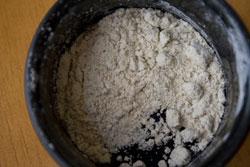 Sorghum Flour
Sorghum Flour - Some people describe the taste as nutty, others describe it as bland or tasteless. I think it adds a great texture to baked goods, along with valuable protein. It is a very popular flour in the gluten free community and one that I use frequently. Authentic Foods Sorghum Flour at Amazon
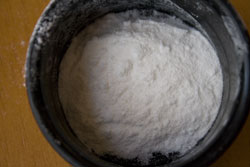 White Rice Flour/Brown Rice Flour-
White Rice Flour/Brown Rice Flour-- These are interchangeable in recipes. The brown rice flour is whole grain and is therefore better for you. If you are concerned about the food budget, buy white rice flour. It is cheaper to buy white rice flour at ethnic grocery stores than your health food store. Rice Flour is great for making a roux and as part of a gluten-free all-purpose baking mix. In recipes that call for a small amount of flour, I normally just throw in rice flour. Brown Rice Flour at Amazon
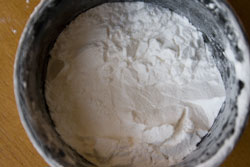 Sweet Rice Flour-
Sweet Rice Flour-- this is my preferred flour for making a roux. It is an excellent addition to any baking mix and wonderful in pizza and breads. I have started using this flour a lot recently. The almond torte (pic above) was made with a little bit of sweet rice flour. A must-have!Authentic Foods Sweet Rice Flour at Amazon
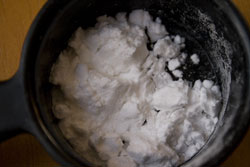 Tapioca Starch/Flour-
Tapioca Starch/Flour- - A great binder in baked goods when used in combination with other flours. It is also a great thickener for sauces. The great thing about tapioca flour is that it will thicken at a low temperature. It will keep in an airtight container in the fridge for two years, but I go through a box in about three weeks! Tapioca Flour at Amazon
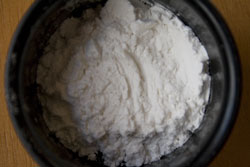 Potato Starch-
Potato Starch- - Not to be confused with potato flour, potato starch is a wonderful thickener and can tolerate higher temperatures than cornstarch. It adds moisture to baked goods. A lot of mainstream flourless chocolate cakes recipes contain potato starch.
Authentic Foods Potato Starch at Amazon 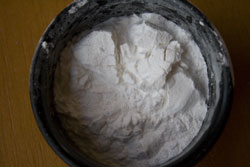 Arrowroot Starch-
Arrowroot Starch- - This is generally considered the most neutral tasting thickener, but it is definitely the priciest! Use arrowroot for acidic sauces. I rarely use this one. I used it at Thanksgiving this year to thicken our gravy, but I may go another route next year. I know a lot of you use it on an occasional basis, so I thought I would mention it here.
Authentic Foods Arrowroot Flour at Amazon 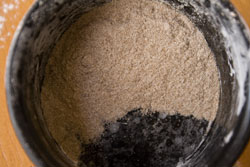 Teff flour-
Teff flour-- This whole grain flour has a mild, nutty, and almost sweet flavor. It imparts a moistness in gluten-free baking. Whole Grain Teff Flour at Amazon
- Buckwheat Flour -
- I stock this flour just so that I can make homemade buckwheat pancakes and waffles occasionally. It is also good as part of a flour combination in muffins and quick breads see my
- Buckwheat Sweet Potato Bread recipe.
Organic Buckwheat Flour at Amazon - Quinoa flour-
- I like baking with this flour because it gives baked goods a nuttier taste. Quinoa flour is wonderfully healthy; it contains a complete protein. I think quinoa flour also lends more moisture to gluten-free baked goods.
Ancient Harvest Quinoa Flour at Amazon - Certified oat flour-
- This flour can be used in baked goods. Make sure you buy oat flour that has been certified gluten-free. I rarely buy this flour because I only tolerate oats on an occasional use basis. Lara’s Oat Flour at glutenfree.com
- Coconut flour-
- This flour adds moisture to baked goods. It is a great addition to chocolate desserts! Bob’s Red Mill Organic Coconut Flour at Amazon
- Almond Meal-
- This meal/flour adds moisture and protein to baked goods. I use it in baked goods all the time. The cake above was made with almond meal, sweet rice flour, and brown rice flour. It is also great for making pie crusts or cheesecake crusts!
Bob’s Red Mill Almond Meal/Flour at Amazon - Hazelnut Meal-
- This meal/flour also adds protein and moisture to baked goods. I make a hazelnut cheesecake and use hazelnut meal for my cookie crust. I buy it for specialty desserts only. Bob’s Red Mill All-Natural Hazelnut Meal/Flour at Amazon
****This is by no means an exhaustive list, but I hope it gets you on your way to your own personal practically perfect gluten free flour blend!****
- MORE GLUTEN FREE BAKING NECESSITIES
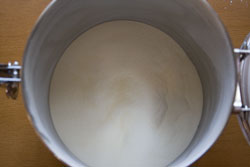 Xanthan Gum-
Xanthan Gum-- This works wonders for gluten-free baked goods. It is expensive, but you only use a little at a time. I only use about a teaspoon for quick bread! It is a great binder. I keep this in a canister. If it spills, do not get it wet because it becomes very sticky and hard to remove. To remove xanthan gum once it has hardened, I use a spatula.
Bob’s Red Mill Xanthan Gum at Amazon - Baking Soda-
- I like Bob’s Red Mill Baking Soda.
- Baking Powder-
- Make sure it is aluminum-free and gluten-free. Featherweight Baking Powder is gluten-free and also corn-free. Make sure your baking powder is less than six months old.
- Go check out more gluten free flour mixes at Gluten Free Cooking School.
If you liked this post, please Stumble it! or Add to Del.icio.us.
Posted on January 24th, 2008 by Natalie
Filed under: gluten free flour
More Posts Like This:
- Fruit and Nut Cookies
- Banana Bread
- Baking Gluten Free Bread: Millet Oatmeal Bread
- Hummingbird Cupcakes
- Peach Cobbler

 I am
I am  I am
I am  I am
I am
Natalie, this is such a great article. Good job!
good heavens natalie! No wonder you haven’t posted anything this week! That must have taken 2 weeks to work on!! Great post!! Very good information!! Thanks for sharing!!
by the way… what is that cake at the top? A carrot cake? do you have that recipe listed on your site! That looks really yummy!!
Great round-up, Natalie. I’m glad to see you’re feeling better. It’s interesting to see what brands people use for their flours. For example, I use BRM’s sorghum flour since I can find it at my Whole Foods, which is cheaper than paying for shipping via Authentic Foods. However, the only rice flour I’ve ever tried is Authentic Food’s superfine brown rice flour since I’ve heard that it’s the only one that is not gritty. Do you not find BRM’s brown rice flour gritty? I also keep batches of unblanched almond meal in my freezer.
I also keep my flour separate until I whisk them together for that specific recipe. Mostly, I use brown rice flour, sorghum flour, and tapioca starch but I like to experiment with teff flour (it’s awesome for a part of flour in pancakes), quinoa flakes (I usually prefer the taste of the flakes in baked goods to quinoa flour), almond meal, and occasionally use potato starch, arrowroot starch, quinoa flour, and garbanzo flour. I try to use as little corn as possible, and when I do, I try to buy organic since so much corn in genetically-modified. I tried buckwheat flour once before in pancakes, and disliked it, but think that I should try it again in a smaller proportion to the rest of the flour. I also have some pecan meal that I plan on keeping for Passover, when most grains are off limits.
One thing I’m interested in is how you figure out how much baking soda, baking powder, and xantham gum to add to a recipe, especially a recipe that already calls for the soda and powder.
Also, the link to the teff is to the grain, not the flour. I’ve been searching every store for teff grain since I want to try some (I hear it makes an awesome corn-free polenta). Now I know that Amazon carries it!
FYI Amazon Prime is so worth it! Everything arrives in 2 days and we order from it all of the time as it can be cheaper than driving across town to get something, like a new scale! I finally just got one so I could make the recipes all of our Euro GF buddies make. Nice job on the flours! And one more time for the record, I love the new look. I even bought some yarn in these two colors a month ago to knit a mohair scarf.
Wow, what a fantastic post! (And I want to know about the cake too …)
Mary Frances- Thanks for the inspiration! You finally gave me the kick I needed.
Carrie- It is an almond torte cake- I really loved it. I am still playing with the topping/filling though. I went with a slightly almond flavored whipped cream this time, but I am sure there is something more elegant out there. Jude loved it and has eaten it for breakfast for two days. Whole grain flours, nuts….breakfast of champions right?
M- Thanks so much for the informative comments as always. I am going to do some thinking about your baking questions. I am excited about your gluten-free wedding cake too!! Thanks for catching the teff flour link- it is fixed now!!
Ginger- Thanks so much! I think Amazon Prime will be a good thing. I am hoping it will get me reading more too. I haven’t been in a bookstore in a while. haha When we go to the library, we are in the kids section.
Lucy- Gee thanks! The cake is an almond torte cake, which I am working on right now! I am hoping to post the recipe soon.
Natalie -
Wow, wow, and more wow! We are still relatively new to the GF world and I have been dying to have this information!! I have always wondered what the difference between flours are and which to use with what. We’ve been using Pamela’s baking mix but, like you said, it does not work with all recipes as a 1:1 or even in all GF recipes.
This is more valuable to me than I can even say. Thank you.
Shelly
Yay! I am so bookmarking this page. Thanks for putting all of this info into one place. I, too, have a little issue with the bean flours!
I just happen to have sorghum, tapioca flour and brown rice flour on hand — I think I’ll use that combo next time I make some baked goods.
I’ve heard sweet rice flour can also be called glutinious rice flour? I bought some at the Asian grocery store the other day and it thickened a soup of mine nicely. Any clue if they’re one in the same?
Wow, thanks for all this great info.
That is a great post. I must send my mom here to read this. She is always confused about all the flours. I am an Amazon Prime member. I love it! Not only for ordering food which you will get in 2 days but shopping for anything. I always check Amazon first. I did a lot of Christmas shopping with Amazon. You will love it.
i need canisters. i have the bags of ziplocs stuffed together in my cabinet. =)
This post is great… very helpful. Which flours are whole grain flours?
kiss the boys for me!
thank you SOOO MUCH FOR THIS!!
i haven’t even read the article yet
but i can tell that it is JUST what i have
been looking for! still relatively new
to this here celiac life and
miss my baking!
so i really thank you for this post.
back in the kitchen i go!
Excellent post. You quite obviously took a lot of time with it and have a lot of experience with it. My wife and I have been experimenting with adding in some Whey Protein into our recipes. It seems to work very well, to reduce the crumbliness of the resulting items as well as help the breads, pancakes, and other “fluffy” items to fluff up.
I’ve written a little bit about it at http://www.theglutenfreelife.com/whey-protein/ including the amount we mix in. (about 1/4 cup substituted in per 2-3 cups of GF flour)
Caroline- As soon as I posted this I realized a million things I wanted to add. However, the wordpress editor is being evil, so I am going to leave it alone for this evening. I will add in the whole grain notes for you sistah, but later! Oh, and I think Target sells their canisters (stainless steel version) for $19.99 and you might watch for them to go on sale. I need to buy another set myself.
CZ- I hope this helps you! I felt better once I started cooking again too.
Gluten Free Life- I have read that before somewhere. Elizabeth Barbone of Easy Gluten Free Baking does that too I think… I will have to give it a go. Have you tried using it in a pizza crust recipe?
Rock on, Natalie!

I love, love this post.
Thank you for the hard work and effort it took to organize and type up. I’ve been working on a list of substitutions for the varying flours as well and I know it’s a lot of organization.
And I agree with Ginger, the layout and colors are gorgeous.

Great post Natalie!! A ton of work but will benefit many!
The almond torte looks delish. Did you ever hear Bill Cosby’s thing about cake for breakfast?
“Daddy’s great…he gives us chocolate cake!”
I don’t know if you have heard of this new flour that recently came out or not but my husband just bought some for me to use and I read you can use it cup for cup in any recipe. It is called Damata flour. Let me know if you know anything about it. I am trying to make some choc. chip cookies with it tonight b/c I am having a tupperware party and see if I can pass them off as they were made with a gluten flour.
What a wonderful post. I am going to print this off and keep it as a handy reference guide in my kitchen. I still get confused and haven’t really done a lot of different baking yet. That is my main goal this year is to start converting recipes. Thank you so much for posting this.
Shelly- Thanks for commenting! I started out using Pamela’s and it is a great mix, but sometimes it was difficult for me to figure out “what went wrong” in a gluten-free recipe. I like having greater control over the flours and leavening agents.
Lizzie- yes, they are one and the same!
Melanie- I am sending this to my mom too. She has to stock gluten-free flour now. tee hee.
Kate- Rock on. I can’t wait to read that post.
SM- hee hee. Bill Cosby is hilarious. I used to watch his routines all the time.
Sara Long- You are way over my head! If you try it, let me know what you think.
Lea- You are welcome. Yay for baking experiments!
Thanks so much for sharing your journey! We have recently started a gf/cf diet in hopes of helping our ds6 who has severe ADHD and mild Autism. Your blog has been such a help in these past few weeks. And it’s so beautiful too!
Thanks so much for all the info. This is great (and makes a lot of sense in hindsight *sigh*). I’m going to run out to BB&B and get some containers. My dh won’t mind since this idea will force me to clean out the refri.
RE: the potatoes…I sure wish I’d roasted them. I think they would have turned out better. mmmm, potatoes roasted with rosemary….sounds deelish.
Sara
ps glad you are feeling better.
Jennefer- Thank you!
Sara- Haha. The containers help me, but I am sure everyone has a method that works for them. I really don’t keep a lot in my fridge in the way of juice, etc which may be why it works for me. Oh, I have been on a roasted potatoes kick lately because it is easy and delicious. I am feeling much better today. Thanks for asking!
What a wonderful resource. I have tons of bagged flour, but usually opt for Pamela’s for convenience and the Whole Foods 365 brand of baking mixes.
I wish we had more shelving for beautiful labeled jars of different flour. I love that look.
xoox
steph
Lovely post! I’ve been thinking of doing a post like this for a while- I should really get on that. Organization is a big issue with all of our flours, so it can be fun to see what different people do.
Also, I wanted to give you the link for my entry for your menu swap- here it is!
Thanks!
-Sea
[...] at Gluten Free Mommy recently wrote a tremendously helpful article entitled “Gluten Free Grains 101: The Best Flour Blend. She answers a lot of her readers’ questions about gluten free flours and flour mixes as well [...]
Hi again, Natalie,
I’m drooling over the idea of a carrot cake (and your chocolate pumpkin cake with teff, which I promised I’d bake for my fiancé this weekend). I really like the idea of ground nuts, pineapple, carrots, and coconut!
I have the requisite brown rice flour, tapioca starch flour, and almond meal, and plan on substituting more tapioca starch flour for the sweet rice flour (unless you think potato starch or corn starch or something else would be superior). But I’m curious as to what you think I should substitute for the millet. I’ve never used it, and don’t know it’s properties (I thought it might be listed here, which is why I’m posting here). I know there’s only 2 tablespoons of millet flour, so it probably won’t matter, but my ideas include quinoa flour, more brown rice flour, or teff flour. Any suggestions are welcome. Thanks!
Just a note … based on my experiences … some items like potato starch, sweet rice flour, and tapioca flour can be purchased cheaply at Asian stores. But there is NO guarantee they are gluten free!
Crockpot Lady- Thank you. Once I went gf, I had to get more storage space. I am a little high maintenance, but I wanted to be honest with you guys!
M- I think more tapioca flour should be fine and I would use more brown rice flour. Teff would be fine too. The carrot cake recipe is a great gf recipe, so it will be a good one to sub in and out flours anyway. I would get millet flour if you are experimenting with cakes because it has such a fantastic taste. It would be great for a yellow cake. I also made blueberry muffins tonight with my millet flour. Millet flour is my new toy I guess
Still Learning GF- Thanks so much for the comment! I feel better about paying more now
What is the best flour to use for coating chicken and frying or sauteing?
Jill- Thanks for commenting. You can use your baking mix or simply use rice flour or cornstarch. I use rice flour or cornstarch most of the time.
I have tried brown rice flour and tried mixing it with corn flour. This is the best I came up with and it still has a different texture. I found cornstarch to be to gummy. What kind of rice flour do you use? I am using this for chicken limone, francaise, picatta….
Hi, if you are in Australia the Orgran gluten free flours are very good and we have used them in our gluten free bread recipe.
Regards, Ross.
Thank you so much for all of this terrific information! My husband and I have all kinds of allergies which were recently diagnosed and this site is the inspiration we need to start learning to cook differently! Thanks again!
[...] “Gluten Free Grains 101: the Best Flour Blend” - Natalie from glutenfreemommy.com [...]
That’s a terrific post Natalie. It makes me want to start up an import business to get some of the weirder flours here in the UK. I got some sorghum flour from an asian store recently which turned out to be contaminated (luckily I test new flours for gluten first). Anyway, this is a cracking rundown of gluten free flours that I’ll be referring to in my own gluten free baking exploits.
Cheers,
Roger
[...] Gluten Free Mommy’s: Gluten Free Flours 101 This post is amazing - great details, photos and very thorough. I only WISH I were this organized! [...]